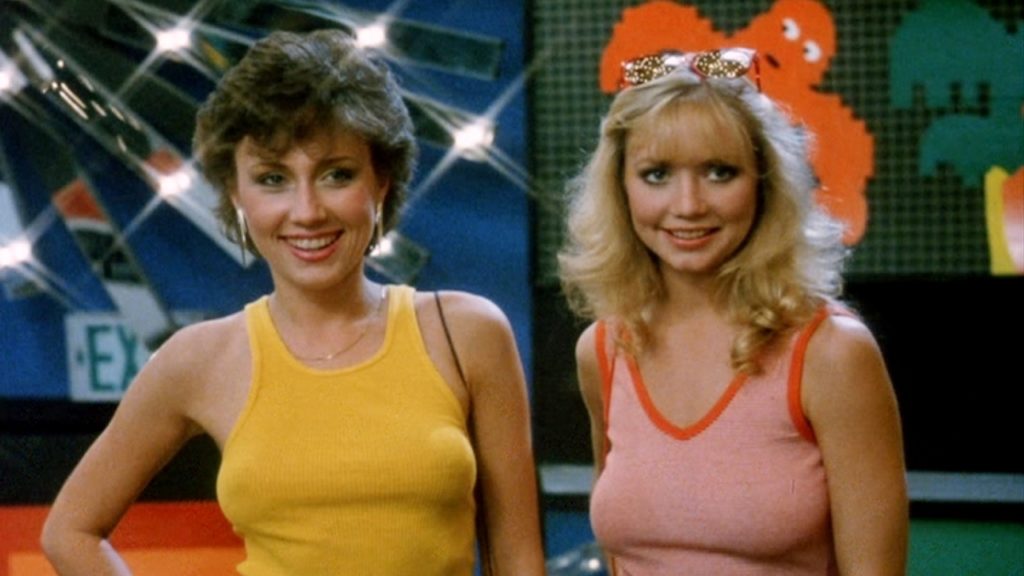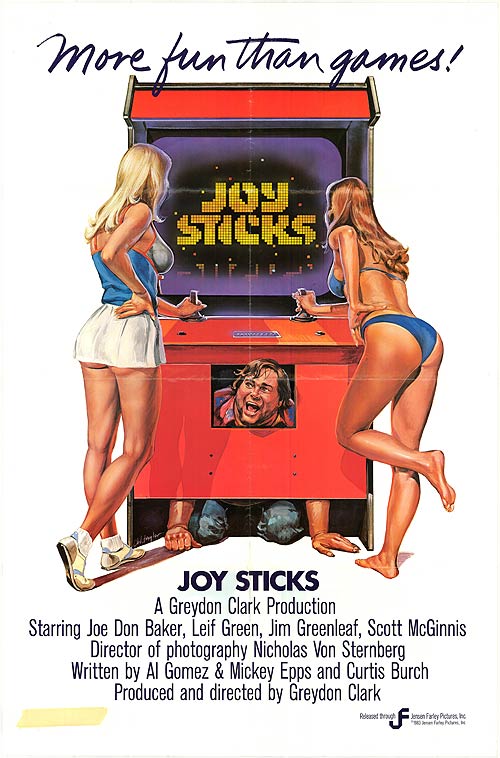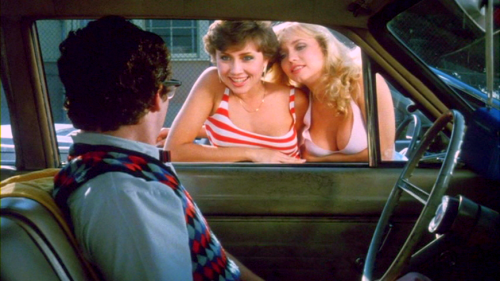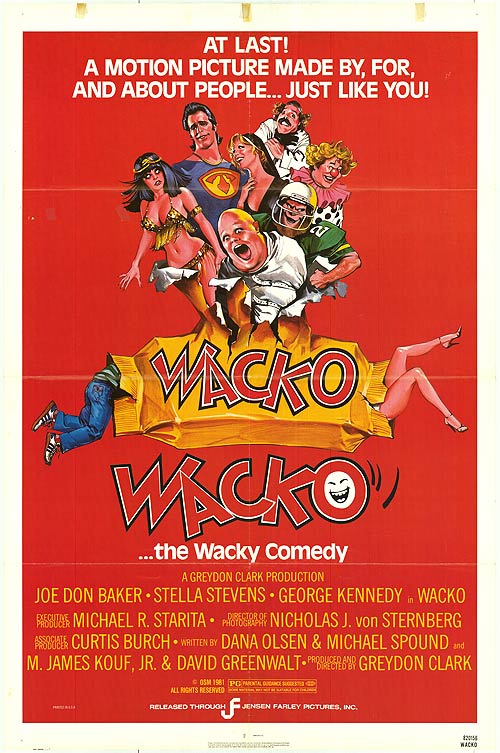“Totally awesome video games!” McDorfus. King Vidiot. Eugene. Coach Straight. “More fun than you can shake your stick at!”
Yes, of course, the subject is JOYSTICKS (1983), writer-director Greydon Clark’s arcade-set teen sex comedy pinnacle that depleted its initial audience of countless Missile Command quarters and that continues to accrue new fans in the manner of Pac-Man gobbling dots as a transition between the movie’s scenes (courtesy of Midway Games, don’t you know!).

JOYSTICKS arrived in the wake of Clark’s affable slasher parody WACKO (1982) and six years after his occult pep squad romp, SATAN’S CHEERLEADERS (1977). The chameleonic filmmaker frequently hopped genres, ranging from bikersploitation (THE BAD BUNCH [1973]) to blaxploitation (BLACK SHAMPOO [1976]) to baldsploitation (SKINHEADS: THE SECOND COMING OF HATE [1989]) to Lambadasploitation (THE FORBIDDEN DANCE [1990]).
Greydon Clark’s career actually extends decades and he has provided us with other cult favorites such as the girl-power action blowout ANGELS BRIGADE (1979), the killer sci-fi freak-out WITHOUT WARNING (1980). He details it all in his absolutely must-read 2013 autobiography, ON THE CHEAP: MY LIFE IN LOW BUDGET FILMMAKING, which is available directly from the auteur/author himself at: GreydonClark.com.
Greydon took some time to discuss both JOYSTICKS and WACKO. It was an honor and an education. And, seriously, buy his book!
DAILY GRINDHOUSE: JOYSTICKS arose from the post-PORKY’S teen sex-comedy craze. It seemed like you had fully absorbed the genre and created something that would truly deliver what the audience wanted.
GREYDON CLARK: The idea for JOYSTICKS came to me when I attended a test screening for my previous film, WACKO, in San Antonio Texas. I arrived at the theater an hour before the screening and when I walked into the lobby I noticed lines of teenage boys on one side of the theater.
I wandered in their direction and saw guys standing in three lines waiting to put their quarters into video game machines. I had never seen sophisticated games like these kids were playing. My first thought, “I could make a movie about video games and teenagers.” Eventually that would become my next movie, JOYSTICKS.
When I got back to Los Angeles from San Antonio I started thinking about video games, teenagers, and sex… Seemed like a very logical thing to make a movie about. Video arcades were booming across the world. An L.A. Times article featured a quote from a parent who thought that her teenage son was spending too much time at the arcade. There was my story: a comedy about an arcade full of teenagers and parents who try to close it down. The protagonists would be the young gamers, the antagonists the parents.
WACKO was doing solid business, and I went to see the distributor about making JOYSTICKS. When I pitched them the idea for an R-rated teen comedy based in a video arcade they immediately agreed to help me with the financing.

DAILY GRINDHOUSE: When you started conceiving and writing JOYSTICKS, what were your specific thoughts on the contemporary teen sex comedy genre?
GREYDON CLARK: I realized that conflict between parents and teenagers was a natural universal fact. When your picture places that conflict in a video arcade with an undertone of sex and comedy there is going to be a large audience for it.
DAILY GRINDHOUSE: What other teen sex comedies did you see as preparation? What did you think of them?
GREYDON CLARK: I have always liked all types of films — all genres, from major studios to the independents. I watched all different kind of films and enjoyed each of them. I didn’t specifically look at teen comedies because I felt that if something is funny, it will get laughs.
Of course, I realized that the protagonists in JOYSTICKS would be teenagers and designed it for that market. At that time the major studios were just beginning to explore the teen market. American International Pictures had for years exploited the teen market. However, they were sold to a group who decided to move away from that market.
DAILY GRINDHOUSE: The other stroke of genius early on was focusing on the video game craze. Did you ever play the games yourself?
GREYDON CLARK: I was not a gamer before making JOYSTICKS. However, during my research while writing the screenplay I started playing at the various arcades in the Los Angeles area. I could see how it would be easy to get hooked on video games – just like McDorfus.
DAILY GRINDHOUSE: JOYSTICKS is full of iconic characters. Please tell us about how you conceived the details for each embodiment of these archetypal figures, and how they changed en route to the screen.
GREYDON CLARK: Each character in JOYSTICKS came generically when we were writing the story. We needed a good-looking romantic hero as our lead and were lucky to cast Scott McGinnis, who’d played a similar role in WACKO.
The character of his best friend, McDorfus, was in homage to John Belushi’s character in ANIMAL HOUSE. Eugene, our classic nerd, helped propel the story along. And King Vidiot could bring early conflict to our story. I felt it was important that all the characters – even King Vidiot – actually loved and revered the arcade.
The main antagonist was the father of Patsy, the Valley Girl, played by Joe Don Baker, who was also in WACKO. It was essential that Joe Don’s character be the overly protective, demanding parent who wanted to close the arcade. Joe Don gave his usual excellent performance.
DAILY GRINDHOUSE: How did JOYSTICKS’ wiener-in-the-cleavage gag come to be?
GREYDON CLARK: I hoped to be able to film the interior of the video arcade in an actual location. However, I soon realized that the arcades were doing so much business that none of them would allow me to film in their establishment. I would have to create the arcade on a soundstage. I designed the set on multiple levels giving me a normal game playing area, a snack bar and a big-screen elevated area for the contests throughout the picture. This was in the days before big-screen television and I was concerned that my actors hunching over a small video screen would not be cinematic. So, I created the big-screen viewing area for the contests.
I needed to control what was happening on the video games when they were on the big screen. I couldn’t rely on my actors’ skill at playing the games. I needed to add the games optically in post-production on the big screens. I filmed hours of video screens for each game and optically put them in my big-screen for each contest.
In the snack bar, we had hot dogs available. Once the set was completed, I realized there was a natural gag, with a wiener somehow ending in the ample cleavage of one of my actresses. It seemed natural that the Eugene character would somehow be involved. I worked it out on the set, and luckily all the actors and crew seemed to think it was funny. I knew we were onto something. It took a couple takes to get the wiener to land in just the right place, but I think it was worth it.

DAILY GRINDHOUSE: What was it like shooting the nude scenes?
GREYDON CLARK: I needed two attractive girls to play opposite Scott McGinnis in nude scenes. If nudity is required for a scene in a film, you must inform the actor’s agent of that fact before setting up interviews.
I always was certain to have an additional person in my office whenever I interviewed actors whether nudity was required or not. Even back then I wanted to make certain there was no confusion about what happened in a casting office.
I saw about a dozen actresses for the roles. Kym Malin, who was the Playboy Playmate of the Month for May 1982, and Kim G. Michel, another attractive young woman, were my final selections. Neither had experience, but both gave excellent readings.
For the final interview, I brought them into my office and had them read a scene together and they seem to have a real chemistry. They each knew that the roles required nudity. I explained in detail how I would film with a closed set and I would be respectful of them as actors. I want a free, fun attitude to come across on film. No inhibitions.
The women explained to me that they had talked about what would be required while they were waiting in the outer office, and each of them assured me there would be no problem with the nudity.
JOYSTICKS was the tenth film I directed. In the early years, nudity was more of a problem — fewer actors were willing to participate. However, the times they were a-changing. Nudity became less of an issue in the filmmaking process. I cast both women, and they were both wonderful to work with.
DAILY GRINDHOUSE: Who wrote and performed the (totally awesome) theme song with the unforgettable chorus, “Totally Awesome Video Games?” What did you think about the song when you heard it?
GREYDON CLARK: When I first heard the song, I was blown away. It was totally awesome and worked as a great opening for the picture. Ray Knehnetsky and Miloangelo Adamo did a terrific job on all the music in the film.

DAILY GRINDHOUSE: The JOYSTICKS poster is a masterpiece. Who came up with the idea? Who painted the final image?
GREYDON CLARK: The distributor showed me a couple of rough drafts for ads. The final one selected was indeed a classic and helped the film’s box office immensely. That was handled by the distributor and sadly I do not know who did the actual artwork.
DAILY GRINDHOUSE: What would you have done if you couldn’t secure the rights to Pac-Man?
GREYDON CLARK: It never occurred to me that I couldn’t secure the rights to some video games. There is no way that I could have created a believable videogame myself. Pac-Man was the dominant game at the time. I needed legal permission to film the copyrighted video games. Midway Games in San Jose, California controlled the rights to Pac-Man.
I was very concerned about the cost of securing the rights since I was on a limited budget. I was hoping that getting the rights to use the iconic Pac-Man character would not be a “budget buster.”
After a brief telephone call with Midway Games, I hopped on a plane and headed to San Jose. I met with a couple company vice presidents and explained the film I was making. I requested the rights to use the Pac-Man character and to film several of their other games.
I decided to take a positive approach and told them I did not expect them to pay me to put their games in my film. I emphasized that they would be getting a lot of free promotion and dangled the possibility of not only using Pac-Man but several of their other games. They were about to release a game called Satan’s Hollow and asked if I could include that in my film. They were asking me if I could do them a favor by using their games in JOYSTICKS. I got the games for no charge.

DAILY GRINDHOUSE: Could you tell us a little bit about the distribution of JOYSTICKS?
GREYDON CLARK: The picture was almost finished with music and sound effects. I had made the picture under the title VIDEO MADNESS but was unhappy with that. I wanted to call the picture JOYSTICK. The distributor objected, saying that every parent in the country would forbid their kids from seeing that. I told him that we should get so lucky that parents protest JOYSTICK. If they do that, we’ll have a huge monster hiton our hands. The kids will get the double meaning. We compromised by adding an “s” to the end of title, and JOYSTICKS was created.
I decided to use the gobbling Pac-Man character to wipe from one scene to the next, and the picture was ready for distribution. The picture opened in approximately 600 theaters and did great business: The best weekend opening ever for the distributor, who was ecstatic.
The following Monday, Entertainment Tonight announced that JOYSTICKS was the number-one picture in the country. Mary Hart wondered how a little picture that no one had ever heard of could lead the nation. I could have told her: a teen sex comedy set in a video arcade was a natural.
Not only had the picture opened to huge business, we held over to exceptional business the second and even third week. Not only was JOYSTICKS doing very well at the box office, we even had some nice reviews from critics.
This little three hundred-thousand-dollar film was even reviewed in People Magazine, with a picture of Joe Don surrounded by two semi-clad girls. When the theatrical distribution of JOYSTICKS was complete, the box office was over four million dollars, not bad for a three-week picture.
DAILY GRINDHOUSE: Did you want to return to the teen sex-comedy genre after JOYSTICKS? If so, what ideas did you have?
GREYDON CLARK: JOYSTICKS was a huge hit in its theatrical release. However, the distributor went bankrupt owing be well over $1 million dollars, which I was never able to collect. That made it very difficult for me to acquire financing for my next films.
I had been working on a teen sex comedy script called HOME FRONT HERO, about a teenager during World War II who “helps” the young women in a small town get through their loneliness while their men are away at war. It was one of the best scripts I ever had. I was ready to film when the distributor went bankrupt. To date, the film has never been made.
DAILY GRINDHOUSE: Why do you think the 1980s teen sex-comedy cycle died out before the decade’s end? Is it just how exploitation film genres work, or was there something else?
GREYDON CLARK: When a genre is successful, many filmmakers jump on the bandwagon — myself included. Then the marketplace becomes saturated, and the box office falls off. The major studios began to look more carefully at the teen market with the success of the AMERICAN PIE franchise and similar films. Ronald Reagan’s tax policies changed the availability of financing for independent films, and the teen market was dormant for several years.

DAILY GRINDHOUSE: Let’s talk WACKO. It is a genuinely hilarious teen slasher send-up. However, it came out during the same period as two other slasher spoofs: STUDENT BODIES (1981) and PANDEMONIUM a.k.a. THURSDAY THE 12th (1982). What do you think of those other films?
GREYDON CLARK: Thank you for your comments on WACKO. I get that often. It is one of my pictures that many people enjoy. Every time I met an audience that sees the picture, the response is overwhelmingly positive. When I decided to make the picture, I was unaware of any other slasher spoofs. Sometimes there’s something in the air that causes similar pictures to be made.
I had some success in the sci-fi thriller genre, specifically on WITHOUT WARNING in 1979. However, comedy was my first love, and I decided I wanted to do a spoof of horror films, something really silly like AIRPLANE!
I felt that since I was working with a low budget I couldn’t compete with the major studios who at that time were not concentrating on the teen market. So, I wanted it to be designed for the teen audience. I contacted the biggest agencies in Hollywood looking for comedy/horror scripts and they flooded in.
I read dozens and found THE LAST HORROR SHOW by Dana Olson and Michael Spound. It had a great concept: a four-year-old girl witnessed her sister being killed by the pumpkin-headed Lawnmower Killer; thirteen years later, it’s Halloween, it’s the Pumpkin Prom and an obsessed cop is on the trail of The Lawnmower Killer — a funny script that I would film as WACKO.

This was years before the first SCARY MOVIE, and before I was aware of any other horror spoofs. After months of rewrites and extensive casting, I went into production on WACKO in 1981. When the picture wrapped, we immediately went into post-production, and I had my first completed print in the spring of 1982.
I was very happy with the picture and felt that we might be able to get major studio distribution. 20th Century Fox was interested and set up a sneak preview in Colorado Springs with one of their pictures I had not heard of, called PORKY’S.
At the time, they were testing PORKY’S in only a couple of markets across the United States. The test audience for WACKO responded extremely well, and I thought 20th Century Fox would make an offer. However, they felt that with one teen comedy already on their schedule they were not interested in another.
I arranged to test-market WACKO in San Antonio, Texas. I flew to Texas from Los Angeles to be at the theater the day we opened. WACKO did very well in San Antonio’s test market. Eventually I made a distribution deal on WACKO with an independent company called Jensen–Farley in Salt Lake City, Utah.
DAILY GRINDHOUSE: What do you think about the SCARY MOVIE franchise in light of WACKO?
GREYDON CLARK: The SCARY MOVIE franchise is very funny and deserves its success. When it came along the major studios had begun to release teen comedies and with their muscle the marketplace responded. WACKO is one of my favorite films and I always felt it did not receive the distribution that it deserved.
DAILY GRINDHOUSE: In Australia, WACKO generated a midnight movie cult following, with audience members dressing up as characters and shouting along with the film. What do you think would have happened if you had released WACKO specifically as a midnight attraction here in the U.S.?
GREYDON CLARK: I receive a lot of fan mail from Australia and my book, On the Cheap: My Life in Low-Budget Filmmaking has done very well with Australian film fans. It would have been very interesting to see what might have happened if WACKO had been released as a midnight attraction. Who knows?
Tags: Greydon Clark, Interviews, Teen Movie Hell



No Comments